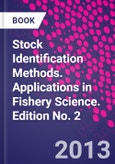Stock Identification Methods, 2e, continues to provide a comprehensive review of the various disciplines used to study the population structure of fishery resources. It represents the worldwide experience and perspectives of experts on each method, assembled through a working group of the International Council for the Exploration of the Sea. The book is organized to foster interdisciplinary analyses and conclusions about stock structure, a crucial topic for fishery science and management.
Technological advances have promoted the development of stock identification methods in many directions, resulting in a confusing variety of approaches. Based on central tenets of population biology and management needs, this valuable resource offers a unified framework for understanding stock structure by promoting an understanding of the relative merits and sensitivities of each approach.
Table of Contents
Foreword Introduction1. Stock Identification Methods: An Overview
2. The Unit Stock Concept: Bounded Fish and Fisheries
3. Fishery Management Strategies for Addressing Complex Spatial Structure in Marine Fish Stocks
Geographic Variation
Life History Traits
4. Quantitative Traits
5. The continuing role of life history parameters to identify stock structure
Morphology
6. Morphometric Landmarks
7. Morphometric Outlines
8. Analysis of growth marks in calcified structures: insights into stock structure and migration pathways
9. Meristics
Environmental Signals
10. Parasites as Biological Tags
11. Chemical Composition of Fish Hard Parts as a Natural Marker of Fish Stocks
12. Fatty Acid Profiles as Natural Marks for Stock Identification
Genetic Analyses
13. Application of Mitochondrial DNA in Stock Identification
14. The Nuclear Genome: Neutral and Adaptive Markers in Fisheries Science
Movement and Mixing
15. The use of early life stages in stock identification studies
16. Conventional and Radio Frequency Identification (RFID) tags
17. Acoustic and Radio Telemetry
18. Estimation of Movement from Tagging Data
19. Telemetry Analysis of Highly Migratory Species
Interdisciplinary Analyses
20. Sampling for Interdisiplinary Analysis
21. Simulation Modeling as a Tool for Synthesis of Stock Identification Information
22. Interdisciplinary Evaluation of Spatial Population Structure for Definition of Fishery Management Units








